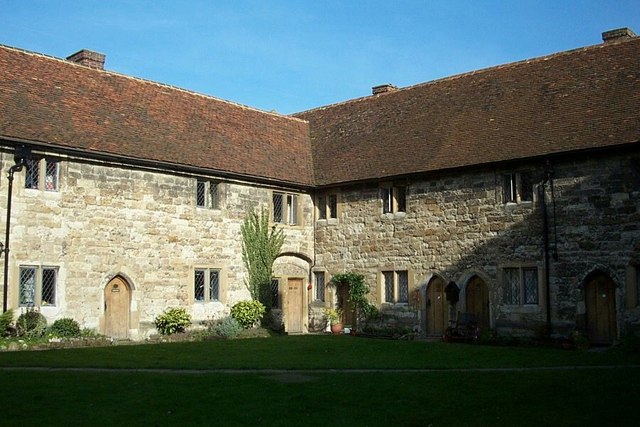Cobham College on:
[Wikipedia]
[Google]
[Amazon]
 Cobham College in the village of Cobham in
Cobham College in the village of Cobham in
 Cobham College in the village of Cobham in
Cobham College in the village of Cobham in Kent
Kent is a county in South East England and one of the home counties. It borders Greater London to the north-west, Surrey to the west and East Sussex to the south-west, and Essex to the north across the estuary of the River Thames; it faces ...
, England, was a chantry employing a college
A college (Latin: ''collegium'') is an educational institution or a constituent part of one. A college may be a degree-awarding tertiary educational institution, a part of a collegiate or federal university, an institution offering ...
of five priests founded by in 1362 by John Cobham, 3rd Baron Cobham (d. 1408), of nearby Cobham Hall
Cobham Hall is an English country house in the county of Kent, England. The grade I listed building is one of the largest and most important houses in Kent, re-built as an Elizabethan prodigy house by William Brooke, 10th Baron Cobham (1527 ...
, lord of the manor
Lord of the Manor is a title that, in Anglo-Saxon England, referred to the landholder of a rural estate. The lord enjoyed manorial rights (the rights to establish and occupy a residence, known as the manor house and demesne) as well as seig ...
of Cobham, for the purpose of praying for the speedy passage of his soul (and those of named others) through Purgatory
Purgatory (, borrowed into English via Anglo-Norman and Old French) is, according to the belief of some Christian denominations (mostly Catholic), an intermediate state after physical death for expiatory purification. The process of purgatory ...
and into Heaven
Heaven or the heavens, is a common religious cosmological or transcendent supernatural place where beings such as deities, angels, souls, saints, or venerated ancestors are said to originate, be enthroned, or reside. According to the belie ...
.
The priests were housed in the surviving building known today as "Cobham College", now a grade I listed
In the United Kingdom, a listed building or listed structure is one that has been placed on one of the four statutory lists maintained by Historic England in England, Historic Environment Scotland in Scotland, in Wales, and the Northern Irel ...
building. It is situated to the immediate south of the parish church of St Mary Magdalene, to the chancel
In church architecture, the chancel is the space around the altar, including the choir and the sanctuary (sometimes called the presbytery), at the liturgical east end of a traditional Christian church building. It may terminate in an apse.
Ove ...
of which it was originally joined by an open processional passageway. In addition to living quarters for the 5 priests, the building contained a communal great hall
A great hall is the main room of a royal palace, castle or a large manor house or hall house in the Middle Ages, and continued to be built in the country houses of the 16th and early 17th centuries, although by then the family used the great ...
with central open hearth.
Dissolution
At the Dissolution of the Monasteries, unlike innumerable other chantries in England which were dissolved by Henry VIII in 1539–40, with their possessions and landholdings being sold-off under the supervision of the Court of Augmentations, the master and brethren of Cobham College surrendered it privately to its patron, George Brooke, 9th Baron Cobham (1497–1558), of Cobham Hall and of nearby Cooling Castle, whose possession was secured by Act of Parliament.Conversion to almshouses
The building formerly housing the chantry priests remained uninhabited until 1597, whenWilliam Brooke, 10th Baron Cobham
Sir William Brooke, 10th Baron Cobham, KG (1 November 1527 – 6 March 1597), lord of the Manor of Cobham, Kent, was Lord Warden of the Cinque Ports, and a member of parliament for Hythe. Although he was viewed by some as a religious radical d ...
(1527–1597), son of the 9th Baron, in his will provided funds for the establishment of 21 almshouses within the abandoned building, to house poor and worthy local elderly people. The old buildings were accordingly divided up into 21 separate dwellings, each having one room on the first floor and one on the ground floor, with its own entrance door. A brass plate above each of the entrance doors names the parish electing the occupying pensioner within.
Modernisation
In 1981 the interior of the college was consolidated to form 13 self-contained dwellings, still in use for charitable purposes. Today the building is managed as a charity operated by "The New College of Cobham (retirement properties)", offering 29 low-rent 1-bedroom dwellings, with resident management staff and lounge, laundry-room, guest facilities and garden. Qualifying residents must be of theAnglican
Anglicanism is a Western Christian tradition that has developed from the practices, liturgy, and identity of the Church of England following the English Reformation, in the context of the Protestant Reformation in Europe. It is one of th ...
faith (members of the Church of England
The Church of England (C of E) is the established Christian church in England and the mother church of the international Anglican Communion. It traces its history to the Christian church recorded as existing in the Roman province of Britain ...
) and formerly resident in one of the following nearby parishes: Chalk, Cliffe, Cobham, Cooling, Cuxton, Gravesend, Halling, Higham, Hoo, St Mary Hoo, Shorue and Strood.
References